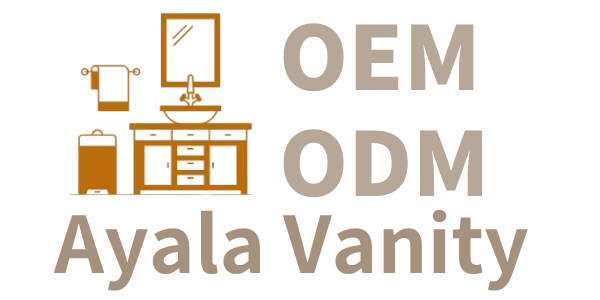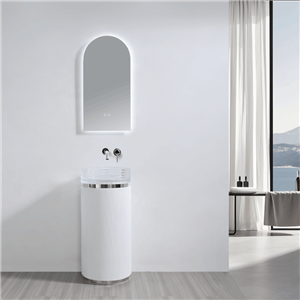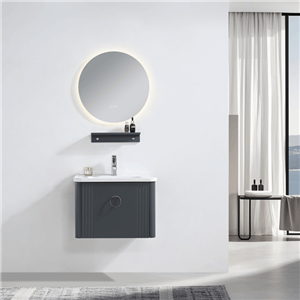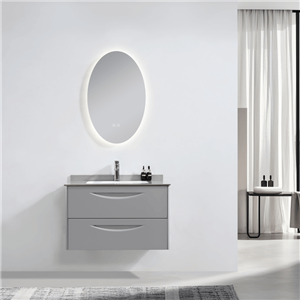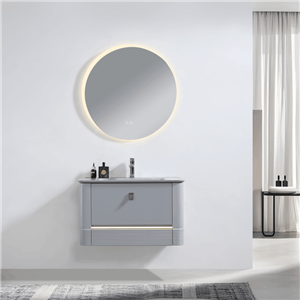The Latest Trends in Bathroom Vanity Designs for 2025
Bathroom vanity designs are evolving faster than ever—and 2025 is shaping up to be a year of bold innovation and smarter solutions. Gone are the days when vanities were purely functional. Today, they serve as centerpieces of bathroom aesthetics, blending storage, tech, and design into a single cohesive unit.
Whether you’re a homeowner looking for a stylish upgrade or a wholesaler aiming to stay ahead of the curve, understanding the latest trends in bathroom vanity designs is crucial. In this article, we’ll walk through the top 10 trends for 2025, offering real examples and actionable insights to help you align with what modern buyers want.
1. Minimalist and Clean-Line Designs Dominate
Minimalism isn't just a trend—it’s becoming the standard in modern bathroom
design. In 2025, expect to see more bathroom vanities with sleek profiles, concealed hardware, and uninterrupted surfaces.
Why It’s Trending
Consumers are favoring simple and calming spaces, especially in urban homes where every inch counts. Clean-line vanities remove visual clutter and create a tranquil environment, perfect for small or spa-style bathrooms.
Key Features
Flat-panel cabinet doors with push-to-open mechanisms
Matte finishes in white, soft gray, or warm oak
Thin countertops with integrated sinks for a seamless look
Real Example
A design studio in Copenhagen recently introduced a bathroom vanity made entirely of recycled birchwood panels with handleless drawers and a soft-touch matte finish. The unit became a hit with clients looking for both environmental responsibility and Scandinavian style.
📊 Table: Popular Minimalist Vanity Features
| Feature | Description |
|---|---|
| Handleless Design | Push-to-open drawers eliminate visual bulk |
| Neutral Color Palette | White, gray, taupe, and soft wood tones |
| Integrated Sink | One-piece surface for modern, clean aesthetic |
| Soft-Close Drawers | Enhances user experience and safety |
2. Floating Vanities for Modern Luxury
Floating, or wall-mounted, bathroom vanities are no longer just a high-end design feature—they're quickly becoming a staple in both residential and commercial interiors. In 2025, their popularity is growing not just for aesthetics but for functionality and smart use of space.
Why It’s Trending
Today’s homeowners and designers are drawn to open, airy bathrooms. Floating vanities lift the furniture off the floor, creating the illusion of more space—especially valuable in compact bathrooms. They also offer easier cleaning access underneath, making them as practical as they are stylish.
Key Benefits
Visually enlarges small bathrooms
Works well with under-cabinet LED lighting
Offers flexible height installation for custom comfort
Supports modern plumbing configurations
Real-World Case Study
A boutique hotel chain in Singapore recently redesigned its guest bathrooms with customized floating vanities. Each unit was crafted from moisture-resistant MDF with a walnut veneer finish, paired with under-mounted ambient LED lighting. The result? Guests praised the bathrooms as “high-end” and “Instagram-worthy,” contributing to a noticeable increase in guest satisfaction ratings.
🛠 Table: Floating vs. Floor-Mounted Vanities
| Feature | Floating Vanity | Floor-Mounted Vanity |
|---|---|---|
| Space Appearance | Makes the room feel larger | Can make the room feel more grounded |
| Cleaning Convenience | Easy to clean underneath | May trap dust at floor level |
| Installation | Wall-mounted, adjustable height | Floor-supported, easier to install |
| Ideal Settings | Modern apartments, hotels, small baths | Traditional homes, large bathrooms |
Floating vanities work especially well with large-format floor tiles and minimalist wall sconces to complete the modern luxury vibe.
3. Natural Materials and Textures
As homeowners seek to create more organic, spa-like environments in their bathrooms, the use of natural materials and tactile textures is becoming a defining trend in bathroom vanity designs for 2025.
Why It’s Trending
Modern bathrooms are no longer just clinical, white-tiled spaces—they’re becoming extensions of the home’s personality. Designers are incorporating warm wood tones, raw stone, and textured finishes to bring depth, warmth, and a sense of nature indoors. This biophilic approach also aligns with growing eco-conscious consumer behavior.
Popular Natural Materials
Solid Wood & Veneers: Oak, walnut, and bamboo are among the top choices for their texture and character.
Stone Countertops: Travertine, marble, and even concrete offer a luxurious, raw finish.
Rattan or Fluted Panels: Adds visual softness and artisanal character.
Eco-MDF & Recycled Composites: Preferred for sustainable mass production.
Design Example
A U.S.-based interior design firm recently completed a high-end residential project using a custom oak vanity with a hand-chiseled travertine top. The client loved the tactile richness of the wood and stone combination—describing the final look as “a luxury retreat that feels grounded.”
📊 Table: Common Natural Materials and Their Characteristics
| Material | Texture Type | Appearance | Eco-Friendly? | Ideal For |
|---|---|---|---|---|
| Oak Wood | Smooth grain | Warm, classic | ✅ | Premium residential builds |
| Bamboo | Fine and vertical | Light, modern | ✅✅ | Sustainable collections |
| Travertine Stone | Uneven, raw surface | Earthy, luxury spa feel | ✅ | High-end hotel bathrooms |
| Recycled MDF | Smooth/varied | Customizable finish | ✅✅ | OEM projects & budget builds |
🌱 Case Insight for B2B Buyers:
Many overseas clients now inquire about FSC-certified wood and low-VOC finishes. Adding these features can significantly boost your brand’s appeal in Western markets.
4. Smart Vanities with Built-in Tech Features
The rise of smart homes is spilling into the bathroom—and vanities are not being left behind. In 2025, smart bathroom vanities equipped with technology are redefining what “functional” really means. They’re not just beautiful—they’re intelligent.
Why It’s Trending
As people spend more time in their homes, convenience and connectivity have become key. Today’s consumers want tech-integrated spaces that make daily routines smoother—from voice-activated lighting to Bluetooth-enabled mirrors. And it’s not just a luxury anymore—it’s a lifestyle expectation, especially among younger homeowners.
Popular Smart Features
Touchless Faucets: Helps conserve water and improve hygiene
Integrated LED Mirrors: Adjustable color temperature and anti-fog features
Bluetooth Speakers: Built directly into the mirror or vanity drawer
USB/Type-C Charging Ports: For grooming tools or phones
Digital Displays: Show time, weather, or even skincare tips
Real-Life Application
A high-end condo development in Vancouver recently installed smart vanities in all its master bathrooms. Each unit featured a fog-free LED mirror with touch controls, built-in speakers, and hidden USB ports. The developer reported that this feature set was one of the most photographed and shared on social media during showings—generating organic marketing buzz.
| Feature | Benefit |
|---|---|
| LED Mirror w/ Dimming | Adjust lighting for makeup or night routines |
| Touchless Faucet | Improves hygiene and reduces water use |
| Bluetooth Audio | Enjoy music or podcasts while getting ready |
| USB Charging Ports | Convenient for hair dryers, razors, phones |
| Digital Clock/Weather | Helps streamline your morning schedule |
5. Bold Colors and Contrasting Tones
In 2025, bathroom vanity designs are embracing color like never before. While white and gray still hold their place, bold hues and contrasting finishes are stealing the spotlight. Designers and homeowners alike are leaning into expressive color palettes that add drama, personality, and a luxurious pop to the space.
Why It’s Trending
As bathrooms become more than just functional spaces, color has become a powerful design tool to reflect mood, style, and even identity. With growing demand for personalized interiors, bold vanities help buyers break free from the "builder-basic" look and create a space that feels unique.
On-Trend Colors for 2025
Matte Black: Timeless, edgy, and pairs well with metallic hardware
Navy Blue: A sophisticated alternative to neutral tones
Forest Green: Evokes nature and brings warmth
Terracotta & Earth Tones: Adds richness and warmth
Two-Tone Styles: Combining wood with deep color lacquer finishes
Design Example
A luxury development in Melbourne recently outfitted its penthouse bathrooms with custom navy-blue vanities with brushed brass hardware and white marble tops. The bold, contrasting palette gave the space a boutique hotel feel, which became a major selling point for high-end buyers.
🎨 Table: 2025 Color Trends in Bathroom Vanities
| Color/Tone | Best Paired With | Vibe/Effect Created |
|---|---|---|
| Matte Black | Gold, white marble, dark wood | Modern, bold, high-end |
| Navy Blue | Brass, light oak, matte white | Sophisticated, calming |
| Forest Green | Natural stone, brushed gold | Earthy, grounded, rich |
| Terracotta | Concrete, black accents, linen tones | Warm, rustic-luxury feel |
| Two-Tone (e.g., wood + black) | Neutral walls, tile patterns | Balanced, designer-friendly |
6. Double Sink Vanities for Shared Bathrooms
As homes evolve to accommodate families, couples, and multi-generational living, double sink vanities have become more than a luxury—they’re a practical must-have. In 2025, demand for well-designed dual-sink setups is surging, especially in master bathrooms and shared family spaces.
Why It’s Trending
Morning routines can get hectic. Double sink vanities offer personal space for two users to get ready simultaneously, without bumping elbows or waiting turns. In upscale homes and even in multi-unit developments, buyers increasingly view dual sinks as a sign of thoughtful design and better usability.
Key Benefits
Shared Use, Separate Space: Reduces daily friction in shared bathrooms
Increased Counter Space: More room for personal care products
Resale Value: Homes with double vanities in the master bath often sell faster
Custom Storage: Separate drawers or cabinets keep things organized
Design Example
A builder in Florida redesigned a luxury coastal home using a 72-inch double vanity with a quartz countertop and two undermount sinks. To visually break the length, the middle section featured open shelving with rolled towels and greenery—creating a spa-inspired look. The homeowner reported that it was their favorite upgrade in the house.
| Feature | Single Sink Vanity | Double Sink Vanity |
|---|---|---|
| Ideal For | Guest bathrooms, small spaces | Master bathrooms, shared spaces |
| Counter Space | Limited | Expanded surface for personal items |
| Storage Options | Compact drawers | Custom split-storage or full-length drawers |
| Resale Appeal | Moderate | High — perceived as a luxury feature |
💡 Design Tip for OEM Buyers:
Offer modular double vanity units where the middle section can be switched between drawers, shelving, or a makeup station.
7. Vintage Revival: Mid-Century and Art Deco Influences
While modern minimalism is still on trend, 2025 is also seeing a powerful return of vintage flair—particularly from the Mid-Century Modern and Art Deco eras. These design styles are making their way into bathroom vanity aesthetics, offering bold charm and timeless elegance.
Why It’s Trending
Consumers are gravitating toward nostalgic design elements that feel both familiar and luxurious. Retro-inspired vanities blend seamlessly into modern interiors while adding unique character. This fusion of old and new resonates strongly with millennials and Gen X buyers who want spaces that tell a story.
Key Vintage-Inspired Features
Fluted Drawer Fronts: A hallmark of Art Deco design
Brass & Gold Accents: Warm metals for handles and legs
Curved Lines: Arched cabinet fronts or rounded corners
Mid-Century Legs: Tapered wood or metal legs for a floating effect
Velvety, Rich Color Palettes: Teal, mustard, dusty rose, and deep plum
Design Example
A boutique renovation project in Chicago reimagined a powder room using a custom teal vanity with fluted drawers, rounded gold handles, and splayed walnut legs. Paired with a globe mirror and patterned wallpaper, it instantly became the most Instagrammed space in the home—and inspired two new client requests.
🧵 Table: Vintage Design Elements and Their Modern Adaptations
| Vintage Feature | Modern Use in 2025 Vanities | Aesthetic Effect |
|---|---|---|
| Fluted Drawer Panels | CNC-cut textured fronts | Adds depth and luxury |
| Brass/Gilded Hardware | Brushed finish on handles, legs | Timeless, warm metallic feel |
| Curved Front Panels | Gentle arches on drawers or sinks | Softens minimalist lines |
| Mid-Century Legs | Wood or metal, elevated bases | Light, airy appearance |
| Bold Colors | Matte finish teal, plum, mustard | Playful yet refined |
🧠 Market Tip for Distributors:
Vintage styles appeal especially to boutique hotel chains, interior designers, and renovation clients. Stocking these could give you a niche advantage.
8. Open Shelving and Display-Friendly Designs
Functionality meets personalization in 2025 with a strong movement toward open shelving bathroom vanities. These designs let homeowners showcase their style while keeping essentials within easy reach—striking a balance between practicality and curated aesthetics.
Why It’s Trending
People are no longer hiding everything behind cabinet doors. Instead, they’re treating their bathrooms like an extension of their living space. Open shelving offers an opportunity to display rolled towels, candles, greenery, or skincare products—turning everyday items into decor.
It also caters to minimalist lifestyles, where intentional living and "less but better" storage choices are valued.
Key Features
Open Bottom Shelves: For baskets, linens, or display items
Combo Configurations: Closed drawers paired with one open shelf
Floating Shelf Extensions: Side or under-vanity shelves for easy access
Natural Wood or Metal Frames: To match industrial, rustic, or boho themes
Real-World Example
A home remodeling firm in Portland outfitted a client’s guest bathroom with a wall-mounted oak vanity that included an open lower shelf. Styled with wicker baskets and folded towels, the vanity became a design focal point and was featured in a local design magazine’s "Small Space, Big Style" issue.
🪞 Table: Pros and Cons of Open Shelf Bathroom Vanities
| Aspect | Pros | Cons |
|---|---|---|
| Aesthetic Appeal | Makes small spaces feel open and styled | Requires tidy arrangement to look clean |
| Functionality | Easy access to daily-use items | Limited privacy for personal items |
| Customization | Great for blending with decor themes | Not ideal for households with clutter |
| Storage Flexibility | Supports baskets, bins, and decorative pieces | Less closed storage for bulk items |
🧺 Tip for B2B Customizers:
Offer clients mix-and-match options: one closed drawer, one open shelf, and one decorative unit. Modular flexibility = higher perceived value.
9. Customization and Modular Configurations
In 2025, bathroom vanities are no longer one-size-fits-all. Instead, manufacturers and designers are embracing customizable and modular configurations to meet the diverse needs of both individual homeowners and bulk B2B clients. Flexibility is no longer a bonus—it’s an expectation.
Why It’s Trending
With the rise of online planning tools and direct-to-consumer furniture brands, buyers want more control over layout, material, finish, and storage style. For dealers, offering modularity also simplifies stock management: the same base can support multiple finishes and configurations, reducing inventory complexity while increasing SKU diversity.
Popular Modular Features
Swappable Sink Locations: Left, right, or center
Expandable Units: Add or remove storage modules as needed
Interchangeable Front Panels: Customize texture, color, and material
Integrated vs. Drop-In Sink Options: Let buyers choose their preferred aesthetic
Custom Drawer Layouts: For beauty products, cleaning supplies, or kid-safe items
Case Example
A European distributor recently partnered with a Chinese OEM to create a modular vanity line where customers could choose the cabinet width (24" to 72"), drawer layout, and color online. The result: over 800 unique configurations using just 6 main SKUs—cutting warehouse costs by 40% while increasing consumer satisfaction.
🧰 Table: Modular Features and Their B2B Advantages
| Feature | Buyer Benefit | Supplier Advantage |
|---|---|---|
| Adjustable Width Modules | Fits various space constraints | Reduces need for separate SKUs |
| Swap-Friendly Front Panels | Easy aesthetic customization | Enables trend updates without full redesign |
| Mix-and-Match Storage Units | Tailored function for each user | Improves perceived value |
| Configurable Sink Positions | Supports layout-specific plumbing | Enhances installation flexibility |
🏗️ Tip for OEM Clients:
Promote your ability to do low-MOQ custom production using standardized base structures with optional components. It’s the sweet spot between efficiency and personalization.
10. Eco-Conscious and Water-Resistant Solutions
As sustainability continues to shape consumer choices, 2025 brings a strong focus on eco-conscious materials and water-resistant engineering in bathroom vanity designs. This shift is not just about saving the planet—it’s about offering better long-term performance and healthier living environments.
Why It’s Trending
Bathrooms are high-moisture zones, and traditional wood or untreated materials often suffer over time. Modern buyers—especially in premium and commercial markets—are looking for materials that last longer, resist warping, and carry environmental certifications. At the same time, builders and wholesalers want vanities that meet regulatory standards for eco-friendly construction and emissions.
Eco-Conscious Features in 2025
Low-VOC Finishes: Reduce indoor air pollutants
FSC-Certified Wood: Responsibly sourced and tracked
Recycled Materials: Reclaimed wood, recycled glass, or eco-MDF
Waterproof Coatings: Laminates and sealants that resist mold/mildew
Durable PVC and PET Laminates: Stylish, resilient, and moisture-proof
Industry Use Case
A commercial contractor outfitting a hotel in Miami selected vanities made from marine-grade plywood wrapped in PET film. The result? Zero swelling or warping after a year of use—even in oceanfront humidity. The project also earned a green building certification, boosting the hotel's brand image and booking rates.
🌿 Table: Eco & Moisture-Resistant Materials at a Glance
| Material/Feature | Benefit | Best Used In |
|---|---|---|
| PET Laminate | High waterproof rating, durable finish | Coastal or humid climates |
| Eco-MDF w/ Low-VOC Coating | Healthier indoor air, renewable sourcing | Eco-conscious residential projects |
| FSC Wood + Waterproof Seal | Combines sustainability with long lifespan | Mid-to-high-end vanity lines |
| Aluminum Framing | Rust-proof, recyclable | Commercial or industrial spaces |
♻️ Sustainability Tip for B2B Sellers:
Include third-party certifications (FSC, CARB, GREENGUARD) on product listings and spec sheets—buyers increasingly demand proof, not just claims.
✅ Conclusion: What's Next in Bathroom Vanity Design
From floating forms and smart features to bold colors and sustainable builds, 2025’s bathroom vanity designs are pushing boundaries—blending function, technology, and style. For suppliers, staying ahead means offering flexibility, customization, and environmentally responsible choices. For homeowners and designers, it means more ways to build a space that’s beautiful, efficient, and uniquely their own.
✨ Whether you’re sourcing for bulk B2B orders or customizing for luxury projects, these trends are your guide to what’s next in bathroom vanity innovation.
